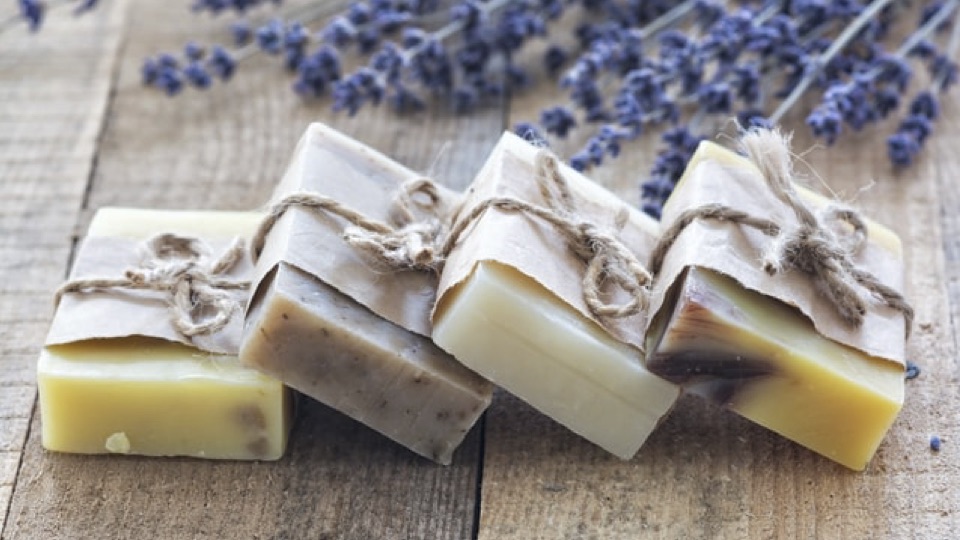Editor’s Note: Our friends at Vermont Soap are dedicated to crafting great organic products in a way that also supports their local community. That’s one reason we’re proud to share their stuff on our site. For another reason, here’s a little explainer from founder Larry Plesent on why “organic soap” is better all around.
***
It takes a full month to make a bar of handmade soap. Why bother? In this episode of Organic 201 we will explore the world of handmade, cold process, or poured bar soaps (they are all the same thing); crystal structure, and how the ingredients and manufacturing process create the mildness or harshness of the bar itself.
Soap making is the art of taking oils which make you dirty and turning them into soap which makes you clean.
But let’s start at the beginning… of human civilization. As far as we know right now, best guess is that somewhere around 5,000 years ago people began figuring out that if water ran through ashes and then onto animal carcasses, the resulting “yellow water” in the river cleaned clothes better than water alone. This process was refined through time most notably in Babylonia and the Greek Isle of Lesbos. To this day, Syria, formerly part of the ancient Babylonian empire, lays claim to the invention of bar soap. The bar soap method we use at Vermont Soap is directly linked to “Aleppo Soap” from Syria. This method was then brought to Marseille, France, making that city renowned for its soap and other “luxury” goods.
Like the art of baking, soapmaking utilizes a small number of ingredients to create a wide range of product variations. The basic ingredients are base oils, water, alkali, color/scent/texture/botanicals and often a preservative. Let’s break it down:
Base Oils refers to the plant nut or seed oils that are turned into the bar soap. Quality bar soaps are usually a mix of stearins (oils that are solid at room temperatures) and oleins (oils that are liquid at room temperatures).
Water refers to the cleanest, most consistent, and least mineralized filtered water possible. Minerals in the water bind with the alkali, tying up its potency and messing with the formula.
Alkali in bar soap making usually refers to potassium hydroxide or sodium hydroxide. Potassium hydroxide can be leached from wood ashes and was the primary alkali used to make soap up until modern times. Today potassium hydroxide is primarily used to manufacture liquid and gel soaps. Sodium hydroxide strongly encourages the mixture to turn into a hard soap rather than a liquid soap. This allows it to dry hard faster, hold together well, and last longer in use.
Sodium or potassium hydroxide is first dissolved into water much like sugar into tea. The solution is slowly blended into a warm melted vegetable oil blend. More oleins make a softer, milder bar. More stearins make the bar harder and longer-lasting.
Vegetable oils are made up of chains of carbon and hydrogen holding hands. Short chains make quick, large soap bubbles that show the user that their soap foams (works). These first bubbles fade fast and have some inherent harshness to them. Long carbon chains make lots of small soap bubbles that take longer to work up into a lather. These are perceived of as feeling mild and luxurious on the skin. You can understand the importance of using a proper blend of oils to create the product characteristics being sought by the marketer!
Essential Oils are powerful plant concentrates that carry the oil-based scent molecules of the plants they come from. Some of these are made by the plant to protect it from fungus, insect, or microbe attacks. We use them because they smell good to us.
Some essential oils relax pores and are better for drier, smaller-pored humans. Some are quite astringent and are best for larger-pored, oilier humans. So when we use essential oils in topical products, the scent blend has an effect, too. With artificial fragrances, the effect is often dryness and irritation to people with sensitive skin. That is why we almost never allow artificial fragrances into our factory!
And now on to the secret of handmade soap. Soap is a crystal. It is a weird crystal that foams. (See our 1-minute video). The size of the soap crystals has a relationship to both the lather and the mildness of the finished product. A fast reaction creates large crystals which are perceived as harsh on sensitive skin. A mediocre reaction results in a mixed bag of crystal sizes. Vermont Soap is legendary among the handful of soap chemistry nerds on the planet for having uniform medium-sized crystals. This is a direct result to the discoveries and innovations we have made over the past 27 years.
This special slow process produces what in theory is the mildest soap product that can be made. Try our Shea Butter Bar Soap on the skin of the most sensitive person you know, and you will see this to be true.
-The NwP Team
Photo by Aurélia Dubois on Unsplash




0 comments on “What’s The Deal with Organic Soap?”